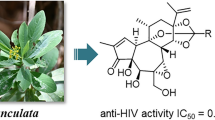Summary
Cepharanthine, isolated fromStephania cepharantha, is one of the bisbenzylisoquinoline-type alka-loids. We have found that it inhibits tumor promotion after topical application in two-stage carcinogenesis in mouse skin. Epidermal ornithine decarboxylase activities inhibited by topical application of cepharanthine, with an 5 Μg/mouse) and mezerein (5 Μg/mouse) were found to be inhibited by topical application of cepharanthine, with a ED50 of 1.2 Μmol and 1.4 Μmol respectively. These inhibitory effects of cepharanthine are considered to be related to its antitumor activity in two-stage carcinogenesis in mouse skin. Cell-mediated immunosuppression by TPA was unaffected by topical application of cepharanthine. A diet containing 0.005% cepharanthine (about 0.5 mg mouse− day−) slightly suppressed the two-stage promotion of skin tumors by twice-weekly applications of 2.5 Μg TPA for 2 weeks (first stage) followed by twice-weekly applications of 2.5 Μg mezerein for 23 weeks (second stage) in ICR mice following initiation by 50 Μg 7,12-dimethylbenz[a]anthracene. Oral administration of cepharanthine inhibits the tumor promotion in two-stage carcinogenesis in mouse skin.
Similar content being viewed by others
Abbreviations
- DMBA:
-
7,12-dimethylbenz[a]anthracene
- DTH:
-
delayed-type hypersensitivity
- ODC:
-
ornithine decarboxylase
- TPA:
-
12-O-tetradecanoylphorbol 13-acetate
References
Blumberg PM (1981) In vitro studies on the mode of action of the phorbol ester potent tumor promoters. CRC Crit Rev Toxicol 9:199–234
Compton SJ, Jones CG (1985) Mechanism of dye response and interference in the Bradford protein assay. Anal Biochem 151:369–374
Diamond L, O'Brien TG, Baird WM (1980) Tumor promoters and the mechanism of tumor promotion. Adv Cancer Res 32:1–74
Goto K, Tanaka R (1984) Cepharanthine protection of Na+, Ca2+-activated adenosine triphosphatase of plasma membranes from rat cerebral synaptosomes against inhibition by ascorbate. Biochem Pharmacol 33:3912–3914
Hasegawa S (1949) Studies on the chemotherapy of tuberculosis. Jpn J Exp Med 20:69–101
Hasegawa S, Shinozuka T (1950) The effect of cepharanthin in the prevention of tuberculosis. Jpn J Exp Med 20:541–557
Hasegawa S, Takahashi K (1949) The effect of cepharanthin on pertussis. Jpn J Exp Med 20:229–234
Hashimoto T, Adachi S, Sato M, Hasegawa S (1950) The cepharanthin treatment of leprosy. Jpn J Exp Med 20:461–472
Kondo H, Keimatu I (1938)Sinomenium andCocculus alkaloids: XLVIII. Constitution of cepharanthine. J Pharm Soc Jpn 58:906–919
Miyahara M, Aono K, Queseda JS, Shimono K, Baba Y, Yamashita S (1978) Protection by cepharanthine of the mitochondrial function from damage induced by snake venom, phospholipase A2, lysolecithin and lead. Cell Struct Funct 3:61–65
Muller HK, Halliday GM, Knight BA (1985) Carcinogen-induced depletion of cutaneous Langerhans' cells. Br. J Cancer 52:81–85
Nakadate T, Yamamoto S, Ishii M, Kato R (1982a) Inhibition of 12-O-tetradecanoylphorbol-13-acetate-induced epidermal ornithine decarboxylase activity by phospholipase A2 inhibitors and lipoxygenase inhibitor. Cancer Res 42:2841–2845
Nakadate T, Yamamoto S, Ishii M, Kato R (1982b) Inhibition of 12-O-tetradecanoylphorbol-13-acetate-induced epidermal ornithine decarboxylase activity by lipoxygenase inhibitors: possible role of product(s) of lipoxygenase pathway. Carcinogenesis 3:1411–1414
Nakagawa S, Kanazawa K, Hirota R, Ishizuka K, Kashiwazaki K, Tanaka M, Sato K (1989) Experimental papilloma development on murine skin and protein kinase C; effect of topical cepharan-thine application. J Nihon Univ Med Assoc 48:868–874
Nihashi Y, Koga Y, Gondo H, Taniguchi K, Nomoto K (1985) Thymus-dependent increase in number of T cells in parathymic lymph nodes induced by the biscoclaurine alkaloid, cepharanthine. Immunobiology 170:351–364
O'Brien TG, Simsimann RC, Boutwell RK (1975) Induction of polyamine-biosynthetic enzymes in mouse epidermis by tumorpromoting agents. Cancer Res 35:1662–1670
Slaga TJ, Fischer SM, Weeks CE, Nelson K, Mamrack M, Klein-Szanto AJP (1982) Specificity and mechanism(s) of promoter inhibitors in multistage promotion. In: Hecker E, Fusenig NE, Kunz W, Marks F, Thielmann HW (eds) Carcinogenesis, vol 7. Raven, New York, pp 19–34
Takeuchi M, Fujiki H, Nitta K (1986) Cell-mediated immune response in mice during the two-stage carcinogenesis experiment by 7,12-dimethylbenz[a]anthracene and 12-O-tetradecanoyl-phorbol-13-acetate. Jpn J Exp Med 56:131–134
Takeuchi T, Sato S (1985) Effect of cepharanthine on cell-type conversion in B16 mouse melanoma cells. J Dermatol 12:138–142
Tamaki K, Fujiwara H, Katz SI (1981) The role of epidermal cells in the induction and suppression of contact sensitivity. J Invest Dermatol 76:275–278
Verma AK, Rice HM, Boutwell RK (1977) Prostaglandins and skin tumor promotion: inhibition of tumor promoter-induced ornithine decarboxylase activity in epidermis by inhibitors of prostaglandin synthesis. Biochem Biophys Res Commun 79:1160–1166
Verma AK, Ashendel CL, Boutwell RK (1980) Inhibition by prostaglandin synthesis inhibitors of the induction of epidermal ornithine decarboxylase activity, the accumulation of prostaglandins, and tumor promotioin caused by 12-O-tetradecanoylphorbol-13-acetate. Cancer Res 40:308–315
Yasukawa K, Takido M, Takeuchi M, Akasu M, Nakagawa S (1989) Inhibitory effect of cepharanthine and its related compounds on 12-O-tetradecanoylphorbol-13-acetate-induced inflammation and inhibition of tumor promotion by cepharanthine in two-stage carcinogenesis in mice. Nihon Univ J Med 31:229–234
Yasukawa K, Takido M, Takeuchi M, Akasu M, Nakagawa SS (1990) Inhibitory effects of flavonol glycosides on 12-O-tetradecanoylphorbol-13-acetate-induced tumor promotion. Chem Pharm Bull (Tokyo) 38:774–776
Author information
Authors and Affiliations
Rights and permissions
About this article
Cite this article
Yasukawa, K., Takido, M., Takeuchi, M. et al. Cepharanthine inhibits two-stage tumor promotion by 12-O-tetradecanoylphorbol 13-acetate and mezerein on skin tumor formation in mice initiated with 7,12-dimethylbenz[a]anthracene. J Cancer Res Clin Oncol 117, 421–424 (1991). https://doi.org/10.1007/BF01612761
Received:
Accepted:
Issue Date:
DOI: https://doi.org/10.1007/BF01612761




